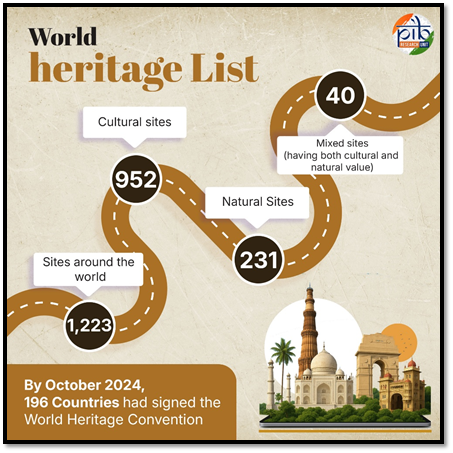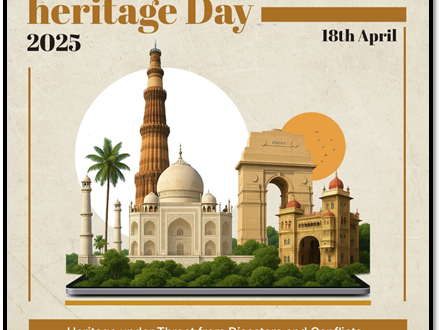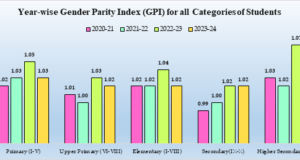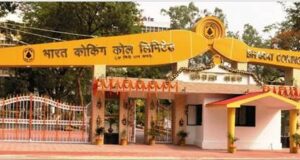“Heritage is not only history. Rather a shared consciousness of humanity. Whenever we look at historical sites, it lifts our mind from the current geo-political factors.”
~ Prime Minster Narendra Modi
Summary
- World Heritage Day is celebrated every year on 18th April to honor and protect cultural and natural heritage.
- This year theme is “Heritage under Threat from Disasters and Conflicts: Preparedness and Learning from 60 years of ICOMOS Actions.”
- The World Heritage Convention is an international agreement created by UNESCO in 1972.
- World Heritage Convention was adopted by countries around the world to protect important cultural and natural sites.
- As of October 2024, there are 1,223 World Heritage Sites across 196 countries (952 cultural, 231 natural, 40 mixed).
- India has 43 World Heritage Sites, with Agra Fort, Taj Mahal, Ajanta, and Ellora Caves among the first listed in 1983.
Introduction
Our heritage is not just built of stones, scripts or ruins. It lives in every whisper of a temple wall, every carving on ancient forts and every folk song passed down through generations. It tells stories of who we were, what we stood for and how we endured. World Heritage Day is a heartfelt reminder that these timeless treasures are not only to be admired, but protected. This year’s theme: “Heritage under Threat from Disasters and Conflicts: Preparedness and Learning from 60 years of ICOMOS Actions” reminds us that preserving our past is key to protecting our future.
The Story Behind World Heritage Day
World Heritage Day is celebrated every year on 18th April. It is also called the International Day for Monuments and Sites. The day is meant to honor and protect human heritage. It also appreciates the people and groups who work to preserve it. The day was started in 1982 by ICOMOS (International Council on Monuments and Sites). Later, in 1983, UNESCO officially adopted it. Every year, ICOMOS gives a special theme for the day. Based on this theme, people and groups hold events and activities around the world to celebrate and protect heritage.
Understanding the World Heritage Convention
UNESCO, which stands for the United Nations Educational, Scientific and Cultural Organization, works to protect and preserve important cultural and natural heritage around the world. To help with this, UNESCO’s member countries adopted the World Heritage Convention in 1972. This agreement explains what countries need to do to find and take care of special sites that can be added to the World Heritage List. India became part of this Convention in November 1977. Today, the World Heritage List includes 1,223 sites that are considered valuable to all of humanity. These include 952 cultural sites, 231 natural sites, and 40 sites that have both cultural and natural importance. As of October 2024, 196 countries have joined the World Heritage Convention.

World Heritage Sites: Protecting Future
World Heritage Sites are special places on Earth that have great value for all of humanity. These can be cultural, natural, or a mix of both. They are protected under an international agreement led by UNESCO. UNESCO gives the World Heritage title to places that are culturally, historically or scientifically important.
Over the years, India has steadily expanded its presence on the World Heritage List. In July 2024, a proud addition was made with the inscription of “Moidams: The Mound-Burial System of the Ahom Dynasty” from Assam as a cultural property. With this, India now has 43 sites on the World Heritage List and 62 more on UNESCO’s Tentative List. The country’s journey began in 1983 with the listing of Agra Fort, followed by the Taj Mahal, Ajanta Caves and Ellora Caves. These sites are preserved not only as symbols of history but also as learning spaces for generations to come.
Government’s Initiatives to Promote India’s Rich Cultural Heritage
India has taken several meaningful steps to protect, restore, and promote its vast cultural and natural heritage. These initiatives reflect the government’s commitment to safeguarding the country’s timeless traditions and historical treasures.
- Retrieval of Antiquities: Archaeological Survey of India is committed to the protection of cultural property. Government has retrieved 655 antiquities from foreign countries from the year 1976 to 2024, of which 642 antiquities have been retrieved since 2014.
- Adopt a Heritage’ Scheme: The “Adopt A Heritage” programme was launched in 2017 and revamped as “Adopt A Heritage 2.0” in 2023. It allows private and public groups to help develop facilities at protected monuments using their Corporate Social Responsibility (CSR) funds. So far, 21 MoUs have been signed between the Archaeological Survey of India and various partner organisations across different states under this programme.

- 46th Session of the World Heritage Committee: Archaeological Survey of India, Ministry of Culture, successfully hosted the 46th Session of the World Heritage Committee in Delhi from 21st to 31st July 2024. The meeting was inaugurated by the Prime Minister, and attended by nearly 2900 international and national delegates from more than 140 countries. Delegates gathered to discuss and collaborate on preserving cultural, natural and mixed heritage marking a significant step in India’s global role in heritage protection.
- Building Monuments of National Importance: India has 3,697 ancient monuments and archaeological sites declared of national importance. The Archaeological Survey of India (ASI) is responsible for their conservation and maintenance. It also ensures basic amenities at these sites, such as pathways, signages, benches, facilities for differently-abled visitors, sound and light shows, and souvenir shops.
- Revival and Redevelopment of Heritage Sites: India has revived key heritage sites through conservation and development projects. The Kashi Vishwanath Corridor in Varanasi, Mahakaal Lok in Ujjain, and Ma Kamakhya Corridor in Guwahati enhance pilgrim experiences and boost tourism. The Chardham Road Project improves connectivity to sacred sites. Additionally, projects in Somnath and the Kartarpur Corridor promote cultural heritage and easier access for devotees.
- Must See Portal: The Archaeological Survey of India (ASI) has created a portal to showcase “Must-See Monuments and Archaeological Sites of India.” It highlights nearly a hundred prominent sites, including World Heritage properties and UNESCO Tentative List sites. The portal provides essential information such as history, access details, facilities and panoramic views. It aims to promote these sites for global visitors. Visit: asimustsee.nic.in
- Digitization of Cultural Heritage in India: The National Mission on Monuments and Antiquities (NMMA), set up in 2007, works to digitize and document India’s heritage and antiquities. So far, over 12.3 lakh antiquities and 11,406 heritage sites have been recorded. For 2024–25, ₹20 lakh was allocated to the mission. The Indian Heritage in Digital Space (IHDS) initiative further aims to use digital technology to preserve and present India’s cultural legacy through immersive tools and research support.
- Status of Classical Languages: On October 3, 2024, the Government granted classical language status to Assamese, Marathi, Pali, Prakrit, and Bengali, raising the total to 11 classical Indian languages. This move reflects India’s strong commitment to preserving its diverse and ancient linguistic heritage.
- India’s first Archaeological Experiential Museum: Union Minister Amit Shah inaugurated the Archaeological Experiential Museum in Vadnagar on 16th January 2025. Built at a cost of ₹298 crore, the museum covers 12,500 square meters. It showcases Vadnagar’s 2,500-year-old history with over 5,000 artifacts, including ceramics, coins, tools and skeletal remains. It features nine galleries and a 4,000-square-meter excavation site offering an immersive experience of ongoing archaeological discoveries.
- Humayun’s Tomb World Heritage Site Museum: On 29th July 2024, a state-of-the-art museum spanning 100,000 square feet was inaugurated at Humayun’s Tomb, a UNESCO World Heritage Site in New Delhi. The museum showcases the site’s rich history, architecture, and conservation journey, offering visitors an immersive cultural experience.
- India’s Literary Milestone on the MOWCAP Register: In a historic achievement, three of India’s literary treasures: Ramcharitmanas, Panchatantra, and Sahrdayāloka-Locana, were inscribed into the 2024 Memory of the World Committee for Asia and the Pacific (MOWCAP) Regional Register. This recognition, announced on 8th May 2024 in Mongolia, underscores the global significance of India’s rich literary and cultural heritage.
Conclusion
World Heritage Day reminds us that protecting our heritage is a shared responsibility. From ancient monuments to timeless literature, India continues to preserve its cultural and natural legacy through strong national efforts and global collaboration. These efforts ensure that our rich heritage inspires, educates, and unites generations to come.
 Odisha news today, Latest Oriya News Bhubaneswar Online Odia news Portal
Odisha news today, Latest Oriya News Bhubaneswar Online Odia news Portal




